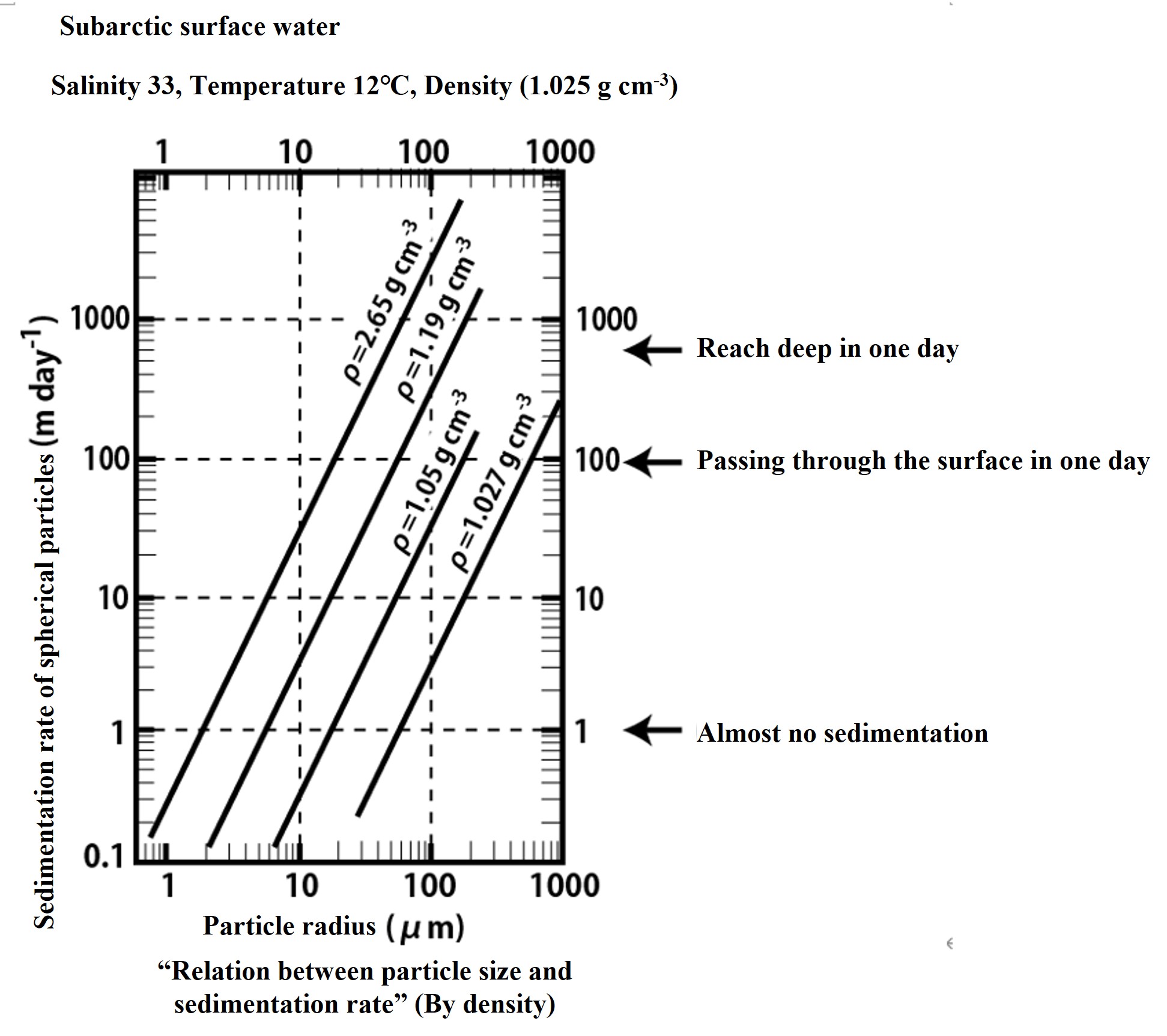Sedimentation of particles (Stokes sedimentation calculation results)
Please look at the Stokes sedimentation equation again.

What we want to find in this equation is the terminal velocity ( sedimentation rate): Vterminal. The unknowns are the radius r and density ρ of the particles. (the density and viscosity coefficient of water are calculated from observations, and the gravitational acceleration is a constant)
Particle radius can be determined by filtering seawater and size fractionating the particles or by irradiating the particles with laser light. Once the seawater density and particle density are determined, the sedimentation rate of the particles can be calculated.
Approximate particle density
Seawater density is about 1.025 g cm-3 and the cytoplasm is slightly denser than seawater, 1.03 to 1.10 g cm-3. Some marine plankton are clad in silicate or calcium carbonate shells, with shell densities ranging from 2.1 to 2.7 g cm-3. The density of particulate organic matter is difficult to determine precisely, but for example, a living organism may be taken as 1.05 g cm-3, assuming that the majority of it is occupied by cytoplasm. Some have adopted 1.19 g cm-3 as the density of fecal grains (海Dynamics of marine living systems ③ Chain of marine organisms, p. 235). Since the soft cytoplasm of the food ingested by the animal is easily digested and much of the shell remains in the feces, the density of the feces is taken to be about between the biological shell and the cytoplasm.
To the ordinary person, the density of feces is a geek's world, but it is important to consider the material cycle in oceanography.
The figure below shows the results of the particle sedimentation rate calculated with density as an assumption and particle radius (r) as a variable.

The figure shows the calculated velocity of particles sedimenting in subarctic surface seawater (25σ), with particle size plotted on the horizontal axis (radius; μm) and terminal velocity (sedimentation rate; m day-1) plotted on the vertical axis. For example, for an organism with a density of 1.05 g cm-3, the sedimentation rate is only 0.3 m day-1 for the size of one individual phytoplankton (10 μm), which effectively does not sediment and remains floating. These particles are called floating particles or suspended particles.
A zooplankton carcass of the same density and size as 100 μm has a velocity of 30 m day-1 and can pass through the surface mixed layer (30 to 150 m thick) within one to several days. Particles with sufficient sedimentation rate are called sedimentation particles.
Aggregation of even a hundred phytoplankton cells can have sufficient sedimentation rate. On the other hand, densely packed fecal particles (density 1.19 g cm-3) with a size of several tens µm have a sedimentation rate of several tens m day-1. Would a zooplankton ten times its size (hundreds µm) fecalize tens of µm.
In the sediment trap observations discussed in Supplement ⑦), some studies have examined in detail the number, size, and density of animal feces in the trap samples. Such studies are called scatology. At this point, we must admit that it is a maniacal world.
If the density of mineral particles (sand grains) blown by the wind from the land is 2.65 g cm-3, the sedimentation rate of mineral particles can be read from the above figure. Yellow sand is a representative example of mineral particles blown by wind in the East Asian region, but the main size of yellow sand particles is only a few μm, so their sedimentation rate in seawater is less than 1 m day-1. This means that it would take more than a decade for yellow sand particles to reach from the ocean surface to 5,000 m below the ocean floor.
According to observations using sediment traps (see below), yellow sand particles seem to sediment at a considerable rate, since it has been reported that yellow sand occurs in early spring and that particles reach the deep ocean one to two months later. One possible reason for this is that mineral particles adhere to huge organic particles (e.g., agglomerates of dead biological organisms), allowing them to reach the deep ocean in a short time. Thus, organic particles also play a decisive role in the vertical transport of inorganic materials.
